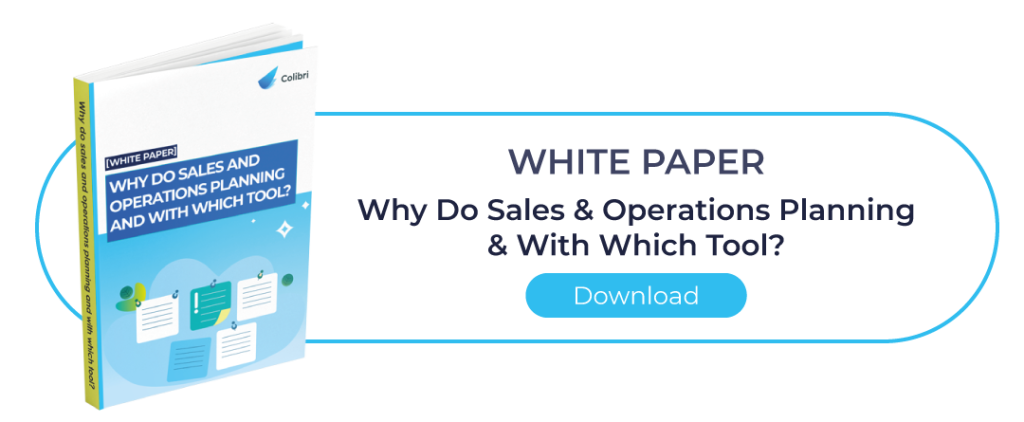The planner, in the broadest sense of the term (demand, supply, S&OP, strategy, etc.), has a central role in the coordination of the company. His mission to control and optimise flows directly impacts customer satisfaction. However, the planner is no longer what it used to be. Since the early 2000s, the many changes in the profession have led to the reinvention of this position for a planner who is new in every way. Here are some explanations.
The planner is dead; long live the planner!
The planner in the Stone Age, a competition between trade and production
Before the 2000s, two departments monopolised power in companies: sales and production. The former’s objective was to maximise turnover and sell the products with the highest potential. The best salespeople were the stars of the company. On the production or sourcing side, the aim was to maximise productivity and, therefore, to limit changes in series and manufacture complex products. This dynamic created two important powers, in agreement until the beginning of the 2000s since the market context remained simple and stable.
But globalisation has led to a change in consumer behaviour and more and more variability. In addition, the consumer has sought more customisation and, therefore, more complexity. This has led to significant coordination and organisation problems within the supply chain, as well as increased stock obsolescence risks.
The 2000s also saw the emergence of logisticians on the market and the introduction of competition between suppliers. With this new paradigm, companies have integrated the notions of quality, reactivity, deadlines, and price.
At the same time, the tools were adapted with the first steps of ERP, but in an ad hoc manner, due to a still developing information systems culture. The consequences were observed on two levels:
- Production orders were sent in all directions, but it was the production that ultimately chose the production order.
- The establishment of planners within companies, but with a lack of a strategy for overall coordination and balancing between load and capacity.
These systems were doomed to failure. Companies had to integrate the S&OP culture into their processes to make it work. The essence of the planner’s job is not global coordination, stockholding strategy, or service rate strategy. These tasks are the responsibility of different departments within the company. The challenge is to coordinate the departments around a global approach. If the company’s other functions are not objectified and aligned on a common company strategy, production produces products that do not sell.
The upheaval of the business with the digitalised supply chain
In the 2010s and 2020s, the generalisation of supply chain best practices and the phenomenon of digitalisation led to the gradual inclusion of the user experience in planning tools. This has led to the widespread use of cloud solutions that are quick to set up, collaborative, scalable and accessible from anywhere.
In addition, demand planning has been a fundamental change in the supply chain profession. This change in the company’s IT world corresponds to a transformation of the generations of planners. It is time to organise, regulate and plan flows.

The planner of the future: tasks, skills, and perspectives
Today, no training course leading to certification is 100% dedicated to the planning profession. The required skills are usually learned “on the job”, primarily through internal development. Despite this, the present and future generations of planners will need to have key competencies, both in terms of know-how and interpersonal skills. Planners will also be equipped with increasingly powerful solutions, which they will need to master but allow them to focus on higher-value tasks.
The serenity
The pressure in this profession or logistics 5-10 years ago is no longer acceptable today. The reason is simple: employees’ resilience is no longer the same.
Automation is necessary to gain peace of mind because it allows you to work by exception and, therefore, to focus on the real problem.
For example, imagine a toy manufacturer with a product catalogue of about thirty references. His customer base is relatively large: he cannot work on all possible combinations. Therefore, he needs a tool that lets him know what he should focus on first. In this respect, working by exception in automation maximises the user’s efficiency.
The notion of efficiency
At the same time, you still need to be as good as possible, but with less time and investment. Take the example of a new product launch: companies conduct research, panels and invest in marketing. By choosing artificial intelligence, it is possible to group typical launch profiles based on product characteristics and the sales behaviour of previous products. AI thus facilitates the work of the planner, who gains in efficiency.
Gender equality
In the medium term, men and women will occupy the planner’s function equally. The evolution is already underway, with parity being built up, at the same time as logistics, in general, is no longer burdened with clichés.
Digital
Companies that rely on digital for their supply chain stand out; they are more competitive and agile. Planners must embrace digital to become more efficient and give their companies a competitive edge.
Versatility
The forecaster is at the crossroads of :
- The trade functions
- The marketing functions
- The finance functions
- The production functions
Thus, as a central point in a logistics chain, they must be able to communicate with everyone: talk about turnover with sales, the number of pieces with logistics, a product family with production, a product launch with marketing, etc. Therefore, the planner must work on different levels of detail: products, customers, and timing. He can thus focus on forecasts and then synthesise all the analysis to pass it on to management so that it can make the right decisions.
Mastering data
Artificial intelligence and robotisation will be essential levers in the work of tomorrow’s forecaster or supply chain planner. The planner must therefore take the data in hand now and be interested in all it can bring.
Conclusion
The multiple competencies of the planner, linked to its constant evolution, show that a global vision is essential. The choice of a digital solution that embodies these trends is therefore essential.
A multi-module S&OP tool, COLIBRI allows you to manage your Sales and Operations Planning from A to Z, to plan, simulate, compare, and make the right decisions according to your objectives. Colibri not only meets the needs of the supply chain business but also projects users into the future to ensure that it can evolve to meet their changing practices and challenges. So, with Colibri, you fully embrace the benefits of S&OP and ensure that you are always one step ahead! Got a project? Do you have a question? Contact us!






